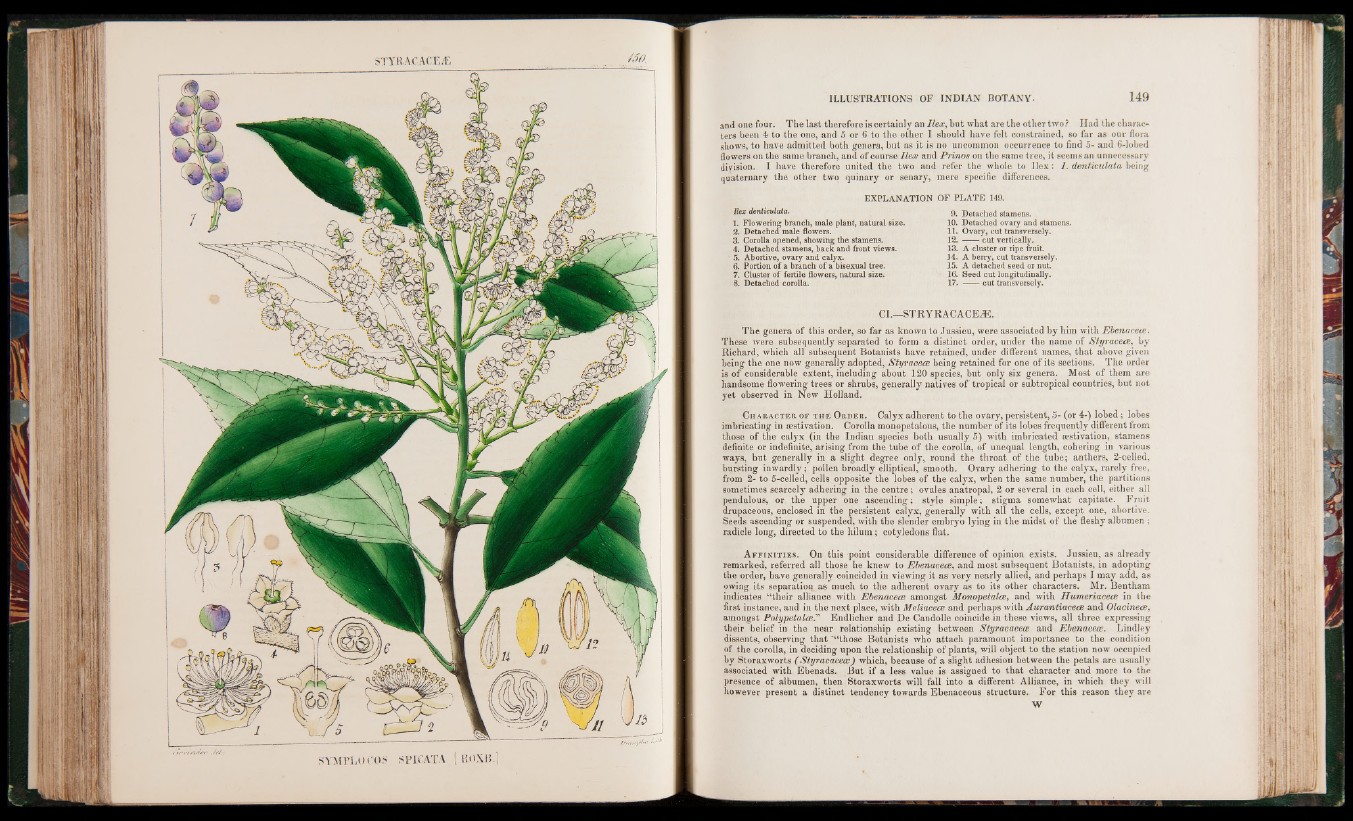
ILLUSTRATIONS OF INDIAN BOTANY- 149
and one four. The last therefore is certainly an Ilex, but what are the other two? Had the characters
been 4 to the one, and 5 or 6 to the other I should have felt constrained, so far as our flora
shows, to have admitted both genera, but as it is no uncommon occurrence to find 5- and 6'-lobed
flowers on the same branch, and of course Ilex and Prinos on the same tree, it seems an unnecessary
division. I have therefore united the two. and refer the whole to Ilex : 1. denticulata being
quaternary the other two quinary or senary, mere specific differences.
EXPLANATION OF PLATE 149.
Rex deniiculata.
1. Flowering branch, male plant, natural size.
2. Detached male flowers.
3. Corolla opened, showing the stamens.
4. Detached stamens, back and front views.
5. Abortive, ovary and calyx.
6. Portion of a branch of a bisexual tree.
7. Cluster of fertile flowers, natural size.
8. Detached corolla.
9. Detached stamens.
10. Detached ovary and stamens.
11. Ovary, cut transversely.
12. ------ cut vertically.
13. A cluster or ripe fruit.
14. A berry, cut transversely.
15. A detached seed or nut
16. Seed cut longitudinally.
17. cut transversely.
CL—STRYRACACE^E.
The genera of this order, so far as known to Jussieu, were associated by him with Ebenacece.
These were subsequently separated to form a distinct order, under the name of Styracece, by
Richard, which all subsequent Botanists have retained, under different names, that above given
being the one now generally adopted, Styracece being retained for one of its sections. The order
is of considerable extent, including about 120 species, but only six genera. Most of them are
handsome flowering trees or shrubs, generally natives of'tropical or subtropical countries, but not
yet observed in New Holland.
Character of the Order. Calyx adherent to the ovary, persistent, 5- (or 4-) lobed; lobes
imbricating in aestivation. Corolla monopetalous, the number of its lobes frequently different from
those of the calyx (in the Indian species both usually 5) with imbricated aestivation, stamens
definite or indefinite, arising from the tube of the corolla, of unequal length, cohering in various
ways, but generally in a slight degree only, round the throat of the tube; anthers, 2-celled,
bursting inwardly; pollen broadly elliptical, smooth. Ovary adhering to the calyx, rarely free,
from 2- to 5-celled, cells opposite the lobes of the calyx, when the same number, the partitions
sometimes scarcely adhering in the centre; ovules anatropal, 2 or several in each cell, either all
pendulous, or the upper one ascending; style simple; stigma somewhat capitate. Fruit
drupaceous, enclosed in the persistent calyx, generally with all the cells, except one, abortive.
Seeds ascending or suspended, with the slender embryo lying in the midst of the fleshy albumen ;
radicle long, directed to the hilum; cotyledons flat.
Af f in it ies . On this point considerable difference of opinion exists. Jussieu, as already
remarked, referred all those he knew to Ebenacece, and most subsequent Botanists, in adopting
the order, have generally coincided in viewing it as very nearly allied, and perhaps I may add, as
owing its separation as much to the adherent ovary as to its other characters. Mr. Bentham
indicates “their alliance with Ebenacece amongst Monopetalce, and with Humeriacece in the
first instance, and in the next place, with Meliacece and perhaps with Aurantiacece and Olacinece,
amongst P o l y p e ta lc e Endlicher and De Candolle coincide in these views, all three expressing
their belief in the near relationship existing between Styracacece and Ebenacece. Lindley
dissents, observing that ‘“those Botanists who attach paramount importance to the condition
of the corolla, in deciding upon the relationship of plants, will object to the station now occupied
by Storaxworts ( Styracacece) which, because of a slight adhesion between the petals are usually
associated with Ebenads. But if a less value is assigned to that character and more to the
presence of albumen, then Storaxworts will'fall into a different Alliance, in which they will
however present a distinct tendency towards Ebenaceous structure. For this reason they are
W